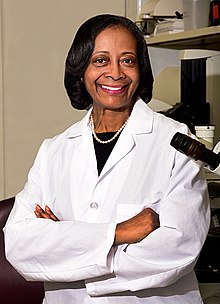Darlene Dixon
Darlene Dixon is an American veterinary scientist and toxicologic pathologist researching the pathogenesis/carcinogenesis of tumors affecting the reproductive tract of rodents and humans and assessing the role of environmental and endogenous hormonal factors in the growth of these tumors. She is a senior investigator at the National Institute of Environmental Health Sciences.
Darlene Dixon | |
|---|---|
 | |
| Born | New Jersey, US |
| Alma mater | Tuskegee University Michigan State University |
| Scientific career | |
| Fields | Toxicologic pathology, veterinary medicine |
| Institutions | National Institute of Environmental Health Sciences |
Education
Dixon was born in New Jersey.[1] She earned a B.S. at Tuskegee University where she completed a Doctor of Veterinary Medicine (D.V.M.) degree in 1982. Dixon earned a Ph.D. in 1985 at Michigan State University. She conducted a postdoctoral fellowship at The Rockefeller University, Laboratory Animal Research Center. Dixon received her board certification from the American College of Veterinary Pathologists (ACVP) in 1987.[2]
Career
Dixion joined the National Institute of Environmental Health Sciences (NIEHS) in 1987. She works as a veterinary scientist and toxicologic pathologist. As of September 2019, she is a senior investigator in the NIEHS National Toxicology Program's Molecular Pathogenesis Group.[2][1]
Dixon is active in the North Carolina Women of Color Research Network (NC WoCRN). She mentors as part of the NIEHS Scholars Connect Program (NSCP), which offers a year-long apprenticeship program to students from historically black colleges and universities, as well as other area academic institutions.[3]
Research
Dixon’s group focuses on defining the pathogenesis/carcinogenesis of tumors affecting the reproductive tract of rodents and humans and assessing the role of environmental and endogenous hormonal factors in the growth of these tumors.[2]
The group has used cell lines, 3D cultures, archival mouse tissue, and human clinical samples to study the influence of membrane-associated estrogen receptors and growth factors/receptors and their signaling pathways on uterine leiomyoma (fibroid) growth. Group members use leiomyoma and patient-matched myometrial samples, clinical tissues taken from cycle-staged, premenopausal women participating in the NIEHS George Washington University Fibroid Study. The rodent tissue samples are either from in-house studies or National Toxicology Program archives.[2]
Dixon and her group seek to understand the basic molecular mechanisms of disease, which may lead to therapeutic interventions that generate alternative non-invasive treatments for clinical fibroids and other diseases affecting the female reproductive tract.[2]
Selected works
- Dixon, Darlene; He, Hong; Haseman, Joseph K. (October 2000). "Immunohistochemical Localization of Growth Factors and Their Receptors in Uterine Leiomyomas and Matched Myometrium". Environmental Health Perspectives. 108: 795–802. doi:10.2307/3454309. JSTOR 3454309.
- Couse, John F.; Dixon, Darlene; Yates, Mariana; Moore, Alicia B.; Ma, Liang; Maas, Richard; Korach, Kenneth S. (October 2001). "Estrogen Receptor-α Knockout Mice Exhibit Resistance to the Developmental Effects of Neonatal Diethylstilbestrol Exposure on the Female Reproductive Tract". Developmental Biology. 238 (2): 224–238. doi:10.1006/dbio.2001.0413. PMID 11784006.
- Flake, Gordon P; Andersen, Janet; Dixon, Darlene (June 2003). "Etiology and pathogenesis of uterine leiomyomas: a review". Environmental Health Perspectives. 111 (8): 1037–1054. doi:10.1289/ehp.5787. ISSN 0091-6765. PMC 1241553. PMID 12826476.
- Daniely, Yaron; Liao, Grace; Dixon, Darlene; Linnoila, R. Ilona; Lori, Adriana; Randell, Scott H.; Oren, Moshe; Jetten, Anton M. (July 2004). "Critical role of p63 in the development of a normal esophageal and tracheobronchial epithelium". American Journal of Physiology. Cell Physiology. 287 (1): C171–C181. doi:10.1152/ajpcell.00226.2003. ISSN 0363-6143. PMID 15189821.
References
- "Darlene Dixon | Office of Equity, Diversity and Inclusion". www.edi.nih.gov. Retrieved 2021-01-01.
 This article incorporates text from this source, which is in the public domain.
This article incorporates text from this source, which is in the public domain. - "Principal Investigators". NIH Intramural Research Program. Retrieved 2021-01-01.
 This article incorporates text from this source, which is in the public domain.
This article incorporates text from this source, which is in the public domain. - "Black History Month observed at NIEHS, NIH (Environmental Factor, February 2019)". National Institute of Environmental Health Sciences. Retrieved 2021-01-01.
 This article incorporates text from this source, which is in the public domain.
This article incorporates text from this source, which is in the public domain.